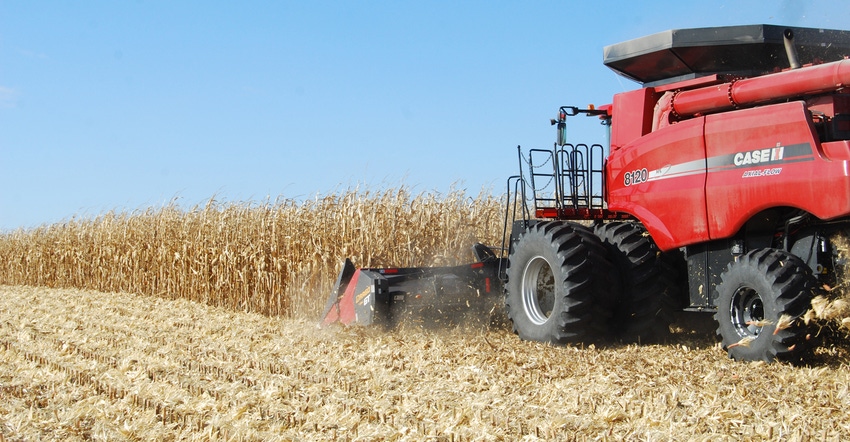September 30, 2019

Taking time to verify that your combine adjustments made in the shop match with the field conditions may seem time-consuming, but it can minimize harvest loss as well as profit loss.
“Knowing how to evaluate for preharvest loss as well as losses during harvest in a corn or soybean field, and the types of in-field adjustments that can be made to minimize harvest losses, is valuable information,” says Kapil Arora, an Iowa State University Extension ag engineering specialist.
To determine what types of adjustments may be warranted, you should first assess if the losses are due to preharvest loss or the harvesting process, he says. In other words, are the losses occurring at the combine head, or at the threshing cylinder and the separation sieves? Arora provides the following guidelines to help you determine where losses may be occurring.
Is your combine properly adjusted?
Paying closer attention to combine settings and improvements in threshing and separation technology has worked well in minimizing grain losses when combining. First, before the combine enters the field, look to see how much preharvesting loss has occurred in the field in these three ways:
1. Check for preharvest loss. Prior to combining, walk up and down a few rows to visually check for dropped corn ears or shattered pods or beans on the ground in a soybean field. As a rule of thumb, four soybeans or two corn kernels per square foot is equivalent to a 1-bushel-per-acre loss. This check serves as a baseline so you can better determine what losses are attributed to the combine. This check can be easily performed when scouting to decide the order in which you should harvest the fields.
2. Check for harvest loss from combine head. Header loss can be responsible for as much as 60% of the total corn loss (PM 574, Profitable Corn Harvesting) and 90% of the total soybean loss (PM 573, Profitable Soybean Harvesting). To determine if loss is from the head, run the combine for 20 to 30 feet and stop before the crop residue spreads over the harvested rows. Back up the combine to expose the harvested area and assess the number of ears, corn kernels, loose beans or beans in pods on the ground. A significant increase in the ear, kernel or bean count on the ground in comparison to the preharvest count indicates that the combine header needs adjusting.
3. Check for harvest losses from threshing cylinder and separating sieves. Harvest losses coming from the threshing cylinder and separating sieves can be evaluated by examining the material being discharged from the rear end of the combine. To evaluate, disengage the residue spreader and harvest 50 to 100 feet of row, allowing the residue to be dropped in a windrow behind the combine. Ensure the throughput of the crop through the combine keeps the threshing unit operating near full capacity. Stop the combine and assess the residue windrow for ears, whole or damaged corn kernels; beans that are loose or damaged; or beans in pods to determine if adjustments need to be made.
Ways to minimize losses
For corn, match the ground travel speed with the stalk roll speed on the header platform, and ensure that the corn ears are not bouncing off the head.
For soybeans, set the reel speed about 25% higher than the travel speed. If soybeans are lodged, increasing reel speed may help pull the plants in better. Minimize grain damage in the threshing unit by increasing or reducing the feeder house material feed to keep the unit fully loaded. This is simply achieved by speeding up or slowing down the ground travel speed of the combine to match with the high yield or low yield areas of the field. In areas of low yields, take care not to increase the ground travel speed excessively such that the threshing unit capacity is exceeded, resulting in increased tailings and grain loss.
Harvesting soybeans with green stem syndrome can be challenging because the grain may be dry while stems are still green. Waiting to harvest until stems are dry may result in significant preharvest loss and threshing unit shatter loss. For adequate threshing of the green-stem soybeans, pay greater attention to the threshing rotor speed and the rotor-concave clearance to avoid green discoloration of the soybean kernels.
For both corn and soybeans, match the air speed with the throughput over the sieves to reduce improper separation in high-yield areas or grain loss in low-yield areas with lighter grain kernels. Keep the airflow toward the upper end of the fan speed and reduce fan speed when faced with lighter grain kernels.
As the fall harvest begins, grain loss and damage can be minimized with proper combine checks during harvest as described above. Be vigilant and do not assume crop harvest conditions. Remember to scout fields to prioritize harvest order based on the drydown conditions and preharvest loss potential.
Source: ISU, which is responsible for information provided and is wholly owned by source. Informa Business Media and subsidiaries aren’t responsible for content in this information asset.
You May Also Like




